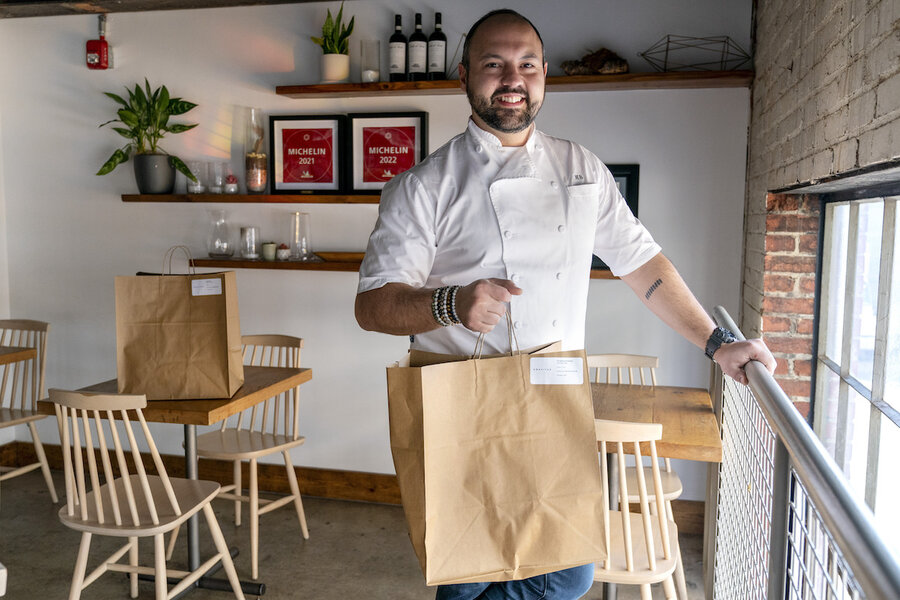Subscriptions aren't just for movies. Now restaurants offer them, too.
Loading...
Consumers are willing to pay monthly subscription fees for streaming services, pet food, and even toilet paper. And now some restaurants are betting they’ll do the same for their favorite meals.
Large chains like Panera and P.F. Chang’s as well as neighborhood hangouts are increasingly experimenting with the subscription model as a way to ensure steady revenue and customer visits. Some offer unlimited drinks or free delivery for a monthly fee; others will bring out your favorite appetizer each time you visit.
They’re following a trend: The average American juggled 6.7 subscriptions in 2022, up from 4.2 in 2019, according to Rocket Money, a personal finance app.
“This is just another way for customers to provide a level of support and joy and love for our offerings,” said Matt Baker, the chef at Gravitas, a Michelin-starred restaurant in Washington.
For $130 per month, Gravitas Supper Club subscribers get a three-course takeout meal for two. Mr. Baker said Gravitas shifted to takeout during the pandemic but saw demand fizzle once its dining room reopened. The Supper Club – which serves about 60 diners per month – keeps that revenue flowing.
The upscale Chinese chain P.F. Chang’s also saw an opportunity to increase to-go orders with its subscription plan, which launched in September. For $6.99 per month, members get free delivery, among other perks.
Other restaurants are experimenting with memberships, which let diners pre-pay toward their visits.
El Lopo, a San Francisco bar, has 26 members in its Take-Care-Of-Me Club. They pay either $89 per month for $100 in dining credits or $175 per month for $200 in credits. When members come in, El Lopo starts bringing out their favorite dishes. On each visit, they can gift a free drink to anyone in the bar.
El Lopo owner Daniel Azarkman started the club in March 2021 to encourage patrons to return as the pandemic eased. Now, he’s hearing from restaurants all over the country who are interested in starting similar programs.
“What it really achieves is getting them in more often,” he said.
Rick Camac, executive director of Industry Relations at the Institute of Culinary Education, said he expects many more restaurants to offer subscriptions in the coming years. Consumers are accustomed to them, he said, and the regular monthly income helps restaurants manage their cash flow.
But not all subscription programs have had success. In 2021, On the Border Mexican Grill introduced its Queso Club, which offered free cheese dip for a year for $1. The program stopped taking new subscribers a year later.
Edithann Ramey, On the Border’s chief marketing officer, said more than 150,000 people signed up for the Queso Club, and members visited seven times more often than the average guest. But the Dallas-based chain wasn’t making enough to cover the cost of the dip.
On the Border is now retooling the program and expects to reintroduce it later this year. It may charge more or move to a monthly model, Ms. Ramey said, but the subscription element will remain.
“It’s becoming kind of a hot trend, and we want to stay as a leading brand,” Ms. Ramey said.
Taco Bell is also tinkering with its $10 Taco Lover’s Pass, which lets subscribers get a taco every day for a month. The pass was introduced in January 2022 and again in October; it generated buzz, but the chain is trying to think of ways to make it more valuable to consumers, said Dane Mathews, Taco Bell’s chief digital officer. A subscription could promise faster service, for example, or unlock unique menu items.
Other restaurants have dropped subscriptions, saying they have their hands full just running the kitchen.
In late 2020, SheWolf, an upscale Italian restaurant in Detroit, started sending subscribers a box of pasta, sauces, and other treats for $80 per month. But when its dining room fully reopened six months later, it was too much work to put together hundreds of boxes.
Still, SheWolf is keeping one foot in the subscription space. Dan Reinisch, the restaurant’s beverage director, sends Italian wines to about 80 subscribers who pay $60 or more each month.
Other businesses have had better luck. St. Louis-based Panera had nearly 40 million members in its loyalty program in early 2020, but it wanted to convince them to drop in more often. So it launched a subscription program that offered unlimited coffee and tea for $8.99 per month. Customers started coming in several times a week, and about one-third of the time they bought food.
Last year, Panera expanded the subscription. Now, members can pay $11.99 per month or $119.99 per year for unlimited hot and cold drinks. Annual subscribers also get free delivery.
Eduardo Luz, Panera’s chief brand and concept officer, won’t share exact numbers but he said members now make up 25% of the chain’s transactions.
“It’s a huge traffic driver,” Mr. Luz said.
The idea quickly spread overseas. Pret A Manger, a sandwich chain owned by the same private company as Panera, launched its own coffee subscription in the U.K. in 2020. As of November, it was being used 1.2 million times per week. Pret also offers subscriptions in France and the United States.
Chris Hosford, a communications consultant in Southern California, joined Panera’s subscription plan a year ago. He passes four or five Paneras on his regular routes and often stops to grab a coffee and a bite to eat.
“It’s not a huge amount of savings for me – probably $5-10 in the average month,” Mr. Hosford said. “But I’m good with that.”
This story was reported by The Associated Press.





